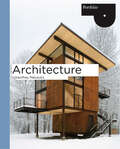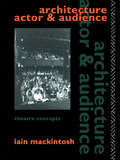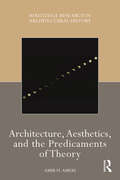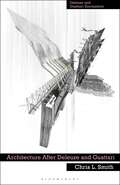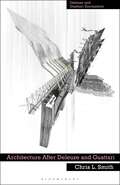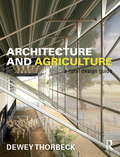- Table View
- List View
Architecturally Speaking: Practices of Art, Architecture and the Everyday
by Alan ReadArchitecturally Speaking is an international collection of essays by leading architects, artists and theorists of locality and space. Together these essays build to reflect not only what it might mean to 'speak architecturally' but also the innate relations between the artist's and architect's work, how they are distinct, and in inspiring ways, how they might relate through questions of built form. This book will appeal to urbanists, geographers, artists, architects, cultural historians and theorists.
Architecture: From Prehistory to Climate Emergency (Pelican Books)
by Barnabas CalderA groundbreaking history of architecture told through the relationship between buildings and energyThe story of architecture is the story of humanity. The buildings we live in, from the humblest pre-historic huts to today's skyscrapers, reveal our priorities and ambitions, our family structures and power structures. And to an extent never explored until now, architecture has been shaped in every era by our access to energy, from fire to farming to fossil fuels.In this ground-breaking history of world architecture, Barnabas Calder takes us on a dazzling tour of some of the most astonishing buildings of the past fifteen thousand years, from Uruk, via Ancient Rome and Victorian Liverpool, to China's booming megacities. He reveals how every building - from the Parthenon to the Great Mosque of Damascus to a typical Georgian house - was influenced by the energy available to its architects, and why this matters.Today architecture consumes so much energy that 40% of the world's greenhouse gas emissions come from the construction and running of buildings. If we are to avoid catastrophic climate change then now, more than ever, we need beautiful but also intelligent architecture, and to retrofit - not demolish - the buildings we already have.
Architecture: Form, Space, and Order
by Francis D. ChingThe revered architectural reference, updated with contemporary examples and interactive 3D models The Interactive Resource Center is an online learning environment where instructors and students can access the tools they need to make efficient use of their time, while reinforcing and assessing their understanding of key concepts for successful understanding of the course. An access card with redemption code for the online Interactive Resource Center is included with all new, print copies or can be purchased separately. (***If you rent or purchase a used book with an access code, the access code may have been redeemed previously and you may have to purchase a new access code -ISBN: 9781118986837). The online Interactive Resource Center contains resources tied to the book, such as: Interactive Animations highlighting key concepts Photo Gallery of architectural precedents illustrated in the book Flashcards for focused learning Architecture: Form, Space, and Order, Fourth Edition is the classic introduction to the basic vocabulary of architectural design, updated with new information on emerging trends and recent developments. This bestselling visual reference helps both students and professionals understand the vocabulary of architectural design by examining how space and form are ordered in the environment. Essential and timeless, the fundamental elements of space and form still present a challenge to those who crave a deeper understanding. Taking a critical look at the evolution of spaces, Architecture distills complex concepts of design into a clear focus that inspires, bringing difficult abstractions to life. The book is illustrated throughout to demonstrate the concepts presented, and show the relationships between fundamental elements of architecture through the ages and across cultures. Topics include: Primary elements and the principles of space design Form and space, including light, view, openings, and enclosures Organization of space, and the elements and relationships of circulation Proportion and scale, including proportioning systems and anthropometry
Architecture: Form, Space, and Order
by Francis D. ChingThe revered architectural reference, updated with contemporary examples and interactive 3D models The Interactive Resource Center is an online learning environment where instructors and students can access the tools they need to make efficient use of their time, while reinforcing and assessing their understanding of key concepts for successful understanding of the course. An access card with redemption code for the online Interactive Resource Center is included with all new, print copies or can be purchased separately. (***If you rent or purchase a used book with an access code, the access code may have been redeemed previously and you may have to purchase a new access code -ISBN: 9781118986837). The online Interactive Resource Center contains resources tied to the book, such as: Interactive Animations highlighting key concepts Photo Gallery of architectural precedents illustrated in the book Flashcards for focused learning Architecture: Form, Space, and Order, Fourth Edition is the classic introduction to the basic vocabulary of architectural design, updated with new information on emerging trends and recent developments. This bestselling visual reference helps both students and professionals understand the vocabulary of architectural design by examining how space and form are ordered in the environment. Essential and timeless, the fundamental elements of space and form still present a challenge to those who crave a deeper understanding. Taking a critical look at the evolution of spaces, Architecture distills complex concepts of design into a clear focus that inspires, bringing difficult abstractions to life. The book is illustrated throughout to demonstrate the concepts presented, and show the relationships between fundamental elements of architecture through the ages and across cultures. Topics include: Primary elements and the principles of space design Form and space, including light, view, openings, and enclosures Organization of space, and the elements and relationships of circulation Proportion and scale, including proportioning systems and anthropometry
Architecture: The Subject is Matter
by Jonathan HillThe aim of this book is to expand the subject and matter of architecture, and to explore their interdependence. There are now many architectures. This book acknowledges architecture far beyond the familiar boundaries of the discipline and reassesses the object at its centre: the building. Architectural matter is not always physical or building fabric. It is whatever architecture is made of, whether words, bricks, blood cells, sounds or pixels. The fifteen chapters are divided into three sections - on buildings, spaces and bodies - which each deal with a particular understanding of architecture and architectural matter.The richness and diversity of subjects and materials discussed in this book locates architecture firmly in the world as a whole, not just the domain of architects. In stating that architecture is far more than the work of architects, this book aims not to deny the importance of architects in the production of architecture but to see their role in more balanced terms and to acknowledge other architectural producers. Architecture can, for example, be found in the incisions of a surgeon, the instructions of a choreographer or the movements of a user. Architecture can be made of anything and by anyone.
Architecture: The Subject is Matter
by Jonathan HillThe aim of this book is to expand the subject and matter of architecture, and to explore their interdependence. There are now many architectures. This book acknowledges architecture far beyond the familiar boundaries of the discipline and reassesses the object at its centre: the building. Architectural matter is not always physical or building fabric. It is whatever architecture is made of, whether words, bricks, blood cells, sounds or pixels. The fifteen chapters are divided into three sections - on buildings, spaces and bodies - which each deal with a particular understanding of architecture and architectural matter.The richness and diversity of subjects and materials discussed in this book locates architecture firmly in the world as a whole, not just the domain of architects. In stating that architecture is far more than the work of architects, this book aims not to deny the importance of architects in the production of architecture but to see their role in more balanced terms and to acknowledge other architectural producers. Architecture can, for example, be found in the incisions of a surgeon, the instructions of a choreographer or the movements of a user. Architecture can be made of anything and by anyone.
Architecture: An Introduction (Portfolio)
by Geoffrey MakstutisThis book offers a thorough introduction to the entire field of architecture, outlining the steps that are normally taken in becoming a qualified architect, from initial education right through to professional practice, as well as how to apply this architectural training in other fields. Complete with feature spreads on individual projects, Architecture: An Introduction's broad, up-to-date approach unites history, theory and practice. Subjects covered include how to develop a brief with a client; taking an idea from brief to project; types of visual presentation including drawings, models and computer renderings; project planning and management; the diverse roles within a company; and the future of architectural practice. This book is a must for anyone considering taking an architecture course or just beginning one.
Architecture: An Introductory Reader (Pocket Library Of Spiritual Wisdom #Vol. 290)
by Rudolf SteinerThe origins and nature of architecture; The formative influence of architectural forms; The history of architecture in the light of mankind's spiritual evolution; A new architecture as a means of uniting with spiritual forces; Art and architecture as manifestations of spiritual realities; Metamorphosis in architecture; Aspects of a new architecture; Rudolf Steiner on the first Goetheanum building; The second Goetheanum building; The architecture of a community in Dornach; The temple is the human being; The restoration of the lost temple.
Architecture 3.0: The Disruptive Design Practice Handbook
by Cliff MoserThis book provides a definitive guide for the future direction of the practice and profession of architecture. In five parts, Cliff Moser provides you with all the tools and know-how to implement changes that will serve you and your practice in the short, medium and long term. Written at a crucial time for the industry, this is essential reading for every architect.
Architecture 3.0: The Disruptive Design Practice Handbook
by Cliff MoserThis book provides a definitive guide for the future direction of the practice and profession of architecture. In five parts, Cliff Moser provides you with all the tools and know-how to implement changes that will serve you and your practice in the short, medium and long term. Written at a crucial time for the industry, this is essential reading for every architect.
Architecture, Actor and Audience (Theatre Concepts)
by Iain MackintoshUnderstanding the theatre space on both the practical and theoretical level is becoming increasingly important to people working in drama, in whatever capacity. Theatre architecture is one of the most vital ingredients of the theatrical experience and one of the least discussed or understood. In Architecture, Actor and Audience Mackintosh explores the contribution the design of a theatre can make to the theatrical experience, and examines the failings of many modern theatres which despite vigorous defence from the architectural establishment remain unpopular with both audiences and theatre people. A fascinating and provocative book.
Architecture, Actor and Audience (Theatre Concepts)
by Iain MackintoshUnderstanding the theatre space on both the practical and theoretical level is becoming increasingly important to people working in drama, in whatever capacity. Theatre architecture is one of the most vital ingredients of the theatrical experience and one of the least discussed or understood. In Architecture, Actor and Audience Mackintosh explores the contribution the design of a theatre can make to the theatrical experience, and examines the failings of many modern theatres which despite vigorous defence from the architectural establishment remain unpopular with both audiences and theatre people. A fascinating and provocative book.
Architecture, Aesthetics, and the Predicaments of Theory (Routledge Research in Architectural History)
by Amir H AmeriArchitecture, Aesthetics, and the Predicaments of Theory offers a critical analysis of the methodological constants and shared critical strategies in the history of theoretical discourse on Western architecture. Central to these constants is the persistent role of aesthetics as a critical tool for the delimitation of architecture. This book analyzes the unceasing critical role aesthetics is given to play in the discourse of architecture. The book offers a close and critical reading of three seminal texts from three different periods in the history of theoretical discourse on Western architecture—the Renaissance, the Enlightenment, and 19th-century Romanticism. The first text is Leone Battista Alberti's Ten Books on Architecture of 1452, the next Marc-Antoine Laugier’s An Essay on Architecture of 1753, and last, John Ruskin’s The Seven Lamps of Architecture of 1849. Additional influential texts from, among others, the 20th and 21st centuries are engaged with along the way to locate and contextualize the arguments within the broader discursive tradition of Western architecture. The book will interest scholars and students of architecture, architectural history and theory, as well as scholars and students of cultural studies, aesthetic philosophy, art history, literary criticism, and related disciplines.
Architecture, Aesthetics, and the Predicaments of Theory (Routledge Research in Architectural History)
by Amir H AmeriArchitecture, Aesthetics, and the Predicaments of Theory offers a critical analysis of the methodological constants and shared critical strategies in the history of theoretical discourse on Western architecture. Central to these constants is the persistent role of aesthetics as a critical tool for the delimitation of architecture. This book analyzes the unceasing critical role aesthetics is given to play in the discourse of architecture. The book offers a close and critical reading of three seminal texts from three different periods in the history of theoretical discourse on Western architecture—the Renaissance, the Enlightenment, and 19th-century Romanticism. The first text is Leone Battista Alberti's Ten Books on Architecture of 1452, the next Marc-Antoine Laugier’s An Essay on Architecture of 1753, and last, John Ruskin’s The Seven Lamps of Architecture of 1849. Additional influential texts from, among others, the 20th and 21st centuries are engaged with along the way to locate and contextualize the arguments within the broader discursive tradition of Western architecture. The book will interest scholars and students of architecture, architectural history and theory, as well as scholars and students of cultural studies, aesthetic philosophy, art history, literary criticism, and related disciplines.
Architecture after Covid
by Albena YanevaAs the COVID-19 pandemic began to unfold in 2020, the lives of billions across the world were transformed. Marching across continents, the invisible killer caused unprecedented disruption worldwide, leading architects and designers to rethink how to design cities and adapt their practice so that we might continue to live together in the future.Architecture after COVID is the first book to explore the pandemic's transformative impacts upon the architectural profession. It raises new questions about the intertwined natures of architectural production, science, society, and spatial practice – questions which had lain latent in the profession for years, but which the COVID pandemic brought to the fore. The book explores how the pandemic modified the spatial conventions of everyday life in the city, and looks in detail at how it has transformed building typologies. It also shows how the continuing risk of pandemics leads us to rethink the social dimension of architecture and urban design; and ultimately proposes a radical re-evaluation of the conditions of architectural practice – making a compelling argument about the changing agency of architectural design and the importance of designers in re-ordering the post-pandemic world. Packed with interviews and case-studies from a wide range of contemporary design practices, Architecture after COVID will inspire debates among architectural practitioners and theorists alike. The broad view of the approach and the depth of the professional issues at stake mean that this book will offer key insights for the discipline long beyond the scope of the COVID pandemic – as it explores the long-lasting bond between city, science and society as the 'new normal' begins to emerge.
Architecture after Covid
by Albena YanevaIn 2020, the COVID pandemic unfolded and transformed the lives of billions across the world. As the invisible killer marched across continents, causing unprecedented disruption worldwide, architects and designers began rethinking how to design cities and adapt their practice so that we might continue to live together in the future. Architecture after COVID is the first book to explore the pandemic's transformative impacts upon the architectural profession. It raises new questions about the intertwined natures of architectural production, science, society, and spatial practice – questions which had lain latent in the profession for years, but which the COVID pandemic brought to the fore. The book explores how the pandemic modified the spatial conventions of everyday life in the city, and looks in detail at how it has transformed building typologies. It also shows how the continuing risk of pandemics leads us to rethink the social dimension of architecture and urban design; and ultimately proposes a radical re-evaluation of the conditions of architectural practice – making a compelling argument about the changing agency of architectural design and the importance of designers in re-ordering the post-pandemic world. Packed with interviews and case-studies from a wide range of contemporary design practices, Architecture after COVID will inspire debates among architectural practitioners and theorists alike. The broad view of the approach and the depth of the professional issues at stake mean that this book will offer key insights for the discipline long beyond the scope of the COVID pandemic – as it explores the long-lasting bond between city, science and society as the 'new normal' begins to emerge.
Architecture After Deleuze and Guattari (Deleuze and Guattari Encounters)
by Chris L. SmithThis study illuminates the complex interplay between Deleuze and Guattari's philosophy and architecture. Presenting their wide-ranging impact on late 20th- and 21st-century architecture, each chapter focuses on a core Deleuzian/Guattarian philosophical concept and one key work of architecture which evokes, contorts, or extends it.Challenging the idea that a concept or theory defines and then produces the physical work and not vice versa, Chris L. Smith positions the relationship between Deleuze and Guattari's philosophy and the field of architecture as one that is mutually substantiating and constitutive. In this framework, modes of architectural production and experimentation become inextricable from the conceptual territories defined by these two key thinkers, producing a rigorous discussion of theoretical, practical, and experimental engagements with their ideas.
Architecture After Deleuze and Guattari (Deleuze and Guattari Encounters)
by Chris L. SmithThis study illuminates the complex interplay between Deleuze and Guattari's philosophy and architecture. Presenting their wide-ranging impact on late 20th- and 21st-century architecture, each chapter focuses on a core Deleuzian/Guattarian philosophical concept and one key work of architecture which evokes, contorts, or extends it.Challenging the idea that a concept or theory defines and then produces the physical work and not vice versa, Chris L. Smith positions the relationship between Deleuze and Guattari's philosophy and the field of architecture as one that is mutually substantiating and constitutive. In this framework, modes of architectural production and experimentation become inextricable from the conceptual territories defined by these two key thinkers, producing a rigorous discussion of theoretical, practical, and experimental engagements with their ideas.
Architecture Against the Post-Political: Essays in Reclaiming the Critical Project
by Nadir LahijiWritten by a team of renowned contributors and carefully edited to address the themes laid out by the editors in their introduction, the book includes theoretical issues concerning the questions of aesthetics and politics and addresses city and urban strategies within the general critique of the "post-political". By focusing on specific case studies from Warsaw, Barcelona, Dubai, Tokyo and many more the book consolidates the contributions of a diverse group of academics, architects and critics from Europe, the Middle East and America. This collection fills the gap in the existing literature on the relation between politics and aesthetics, and its implications for the theoretical discourse of architecture today. In summary, this book provides a response to the predominant de-politicization in academic discourse and is an attempt to re-claim the abandoned critical project in architecture.
Architecture Against the Post-Political: Essays in Reclaiming the Critical Project
by Nadir LahijiWritten by a team of renowned contributors and carefully edited to address the themes laid out by the editors in their introduction, the book includes theoretical issues concerning the questions of aesthetics and politics and addresses city and urban strategies within the general critique of the "post-political". By focusing on specific case studies from Warsaw, Barcelona, Dubai, Tokyo and many more the book consolidates the contributions of a diverse group of academics, architects and critics from Europe, the Middle East and America. This collection fills the gap in the existing literature on the relation between politics and aesthetics, and its implications for the theoretical discourse of architecture today. In summary, this book provides a response to the predominant de-politicization in academic discourse and is an attempt to re-claim the abandoned critical project in architecture.
Architecture and Adaptation: From Cybernetics to Tangible Computing
by Socrates YiannoudesArchitecture and Adaptation discusses architectural projects that use computational technology to adapt to changing conditions and human needs. Topics include kinetic and transformable structures, digitally driven building parts, interactive installations, intelligent environments, early precedents and their historical context, socio-cultural aspects of adaptive architecture, the history and theory of artificial life, the theory of human-computer interaction, tangible computing, and the social studies of technology. Author Socrates Yiannoudes proposes tools and frameworks for researchers to evaluate examples and tendencies in adaptive architecture. Illustrated with more than 50 black and white images.
Architecture and Adaptation: From Cybernetics to Tangible Computing
by Socrates YiannoudesArchitecture and Adaptation discusses architectural projects that use computational technology to adapt to changing conditions and human needs. Topics include kinetic and transformable structures, digitally driven building parts, interactive installations, intelligent environments, early precedents and their historical context, socio-cultural aspects of adaptive architecture, the history and theory of artificial life, the theory of human-computer interaction, tangible computing, and the social studies of technology. Author Socrates Yiannoudes proposes tools and frameworks for researchers to evaluate examples and tendencies in adaptive architecture. Illustrated with more than 50 black and white images.
Architecture and Affect: Precarious Spaces (Routledge Research in Architecture)
by Lilian CheeArchitecture and Affect is motivated by two questions: Why does dismissed affective evidence trouble us? What would it mean for architecture to assemble such discrepant evidence into its discourse? Arguing that the persistent refrains of lived affect dwell in architecture, this book traces such refrains to a concept of architecture wedged in the middle ground—jammed amidst life, things and events. Rather than being aloof from its surrounds, architecture-in-the-midst challenges an autonomous epistemology. Beyond accounting for the vivid but excluded, this book develops a frame and a disposition for thinking critically about, speculatively through, and being grounded by, encounter. Examining affect through a constellation of spaces in contemporary Singapore, it details architecture’s uneasy but inextricable relationship with key subjects relegated to the incommensurate, the peripheral, the scenic and the decorative. The outcome is a politicized architectural discourse simultaneously grounded and speculative; bridging depth and intuition, thinking and feeling.
Architecture and Affect: Precarious Spaces (Routledge Research in Architecture)
by Lilian CheeArchitecture and Affect is motivated by two questions: Why does dismissed affective evidence trouble us? What would it mean for architecture to assemble such discrepant evidence into its discourse? Arguing that the persistent refrains of lived affect dwell in architecture, this book traces such refrains to a concept of architecture wedged in the middle ground—jammed amidst life, things and events. Rather than being aloof from its surrounds, architecture-in-the-midst challenges an autonomous epistemology. Beyond accounting for the vivid but excluded, this book develops a frame and a disposition for thinking critically about, speculatively through, and being grounded by, encounter. Examining affect through a constellation of spaces in contemporary Singapore, it details architecture’s uneasy but inextricable relationship with key subjects relegated to the incommensurate, the peripheral, the scenic and the decorative. The outcome is a politicized architectural discourse simultaneously grounded and speculative; bridging depth and intuition, thinking and feeling.
Architecture and Agriculture: A Rural Design Guide
by Dewey ThorbeckArchitecture and Agriculture: A Rural Design Guide presents architectural guidelines for buildings designed and constructed in rural landscapes by emphasizing their connections with function, culture, climate, and place. Following on from the author’s first book Rural Design, the book discusses in detail the buildings that humans construct in support of agriculture. By examining case studies from around the world including Australia, China, Japan, Norway, Poland, Japan, Portugal, North America, Africa and the Southeast Asia it informs readers about the potentials, opportunities, and values of rural architecture, and how they have been developed to create sustainable landscapes and sustainable buildings for rapidly changing rural futures.




